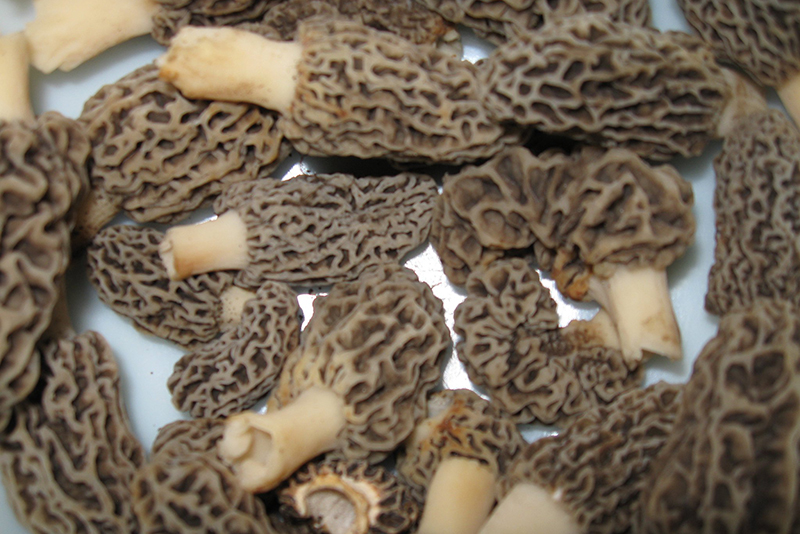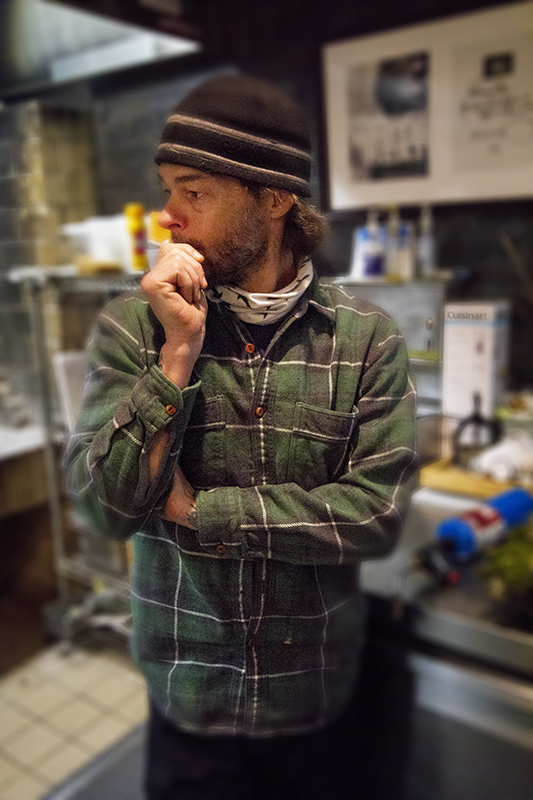Mycological Madness

Thanks to the Pandemic, Mushroom Hunting is an Increasingly Popular Pursuit
By Anne Levin | Photos by Jeffrey E. Tryon

(Photo by Ed Ashton)
Spend some time talking to mushroom foragers about what they do and how they do it, and you are likely to start looking at trees differently. That feathery cluster you spy under an old oak — is that a hen of the woods? That funnel-shaped stalk with yellow flesh, peeking out of some moss — could it be a chanterelle?
Seeking out mushrooms is a treasure hunt that can become addictive. And when the hunt yields culinary prizes, it’s even better. But those fascinated by fungi do not restrict their curiosity to specimens that can be turned into gourmet meals. Photography, cultivation, botanical illustrations, and even jewelry-making can come into the picture. And the practice has become increasingly popular, especially during COVID-19.
“We’ve had an explosion of members this year,” said Jim Barg, a past president of the New Jersey Mycological Association and a consultant to the New Jersey Poison Control Center. “The pandemic definitely has something to do with it. People want to get out into nature and take part in outdoor activities. There are now somewhere between 800 and 900 people in the association.”
 Although mushrooms are classified as vegetables, they are technically part of the kingdom called fungi. The edible ones are nutritious — low in calories, almost devoid of fat and cholesterol, and low in sodium.
Although mushrooms are classified as vegetables, they are technically part of the kingdom called fungi. The edible ones are nutritious — low in calories, almost devoid of fat and cholesterol, and low in sodium.
Mushroom hunters tend to be tight-lipped about where they look. “Foragers are very protective,” said Princeton resident Steve Omiecinski, who ventures out on hunting expeditions in and around town, and in upstate New York where he and his family have a home. “No one wants to share their spots. The last thing I want is to find other people looking in my good places.”
“I have not found anybody who will share where they have found mushrooms, and I understand why,” says Ed Ashton, who lives in Hunterdon County and does technological work and facilities maintenance when not pursuing black trumpets, oysters, lion’s mane, and other mushroom varieties. “You really don’t want to go to a wild mushroom patch and find somebody else there already.”

Commonly known as the violet coral or the magenta coral, this brightly colored fungus is Clavaria zollingeri.
Barg, who also keeps mum about specifics, reveals a bit of information. “One of the places not to look is a maple forest,” he said. “The best spots are generally oak forests and pine forests — especially scrub pines that we have in South Jersey. I try to avoid going to places where you’ll have trouble with park rangers. Regulations are sketchy. It depends on the park ranger you see. Some get nasty about it, others don’t.
I personally was issued a summons for picking morels in the spring on federal land. One of the best ways to forage is to go to somebody’s land that has woods on it — if you know them.”
Safety is paramount when it comes to mushroom hunting. Some species are poisonous and knowing how to recognize and avoid them is key. In the book Mushrooming Without Fear, author Alexander Schwab advises novices: “As a beginner, leave alone most mushrooms you pass. Look closely at what you see before you, not at what you wish was there. Stick to the rules and tick off every stage in the mushroom identification process.”
Schwab classifies mushrooms into four categories: gills, tubes, spines, and ridges. Repeatedly in the book, he issues the warning: “Never, ever take a mushroom with gills.”

An elegant plating of the hen of the woods mushroom on hickory bark and moss at Elements.

Chef Scott Anderson at Elements.
Scott Anderson, co-owner and chef at the Princeton restaurant Elements, is an avid mushroom hunter. When in season, they figure prominently on the restaurant’s menu.
“Mushroom seasons are really short,” he said. “You have a short window to gather as much as possible. Morels are first. We get tons of morels, chanterelles, porcini, and hen of the woods. Spring through fall, we never have a gap. When people know we have chanterelles, they are excited.”
Anderson relies on Barg to tell him which mushrooms are safe. “We don’t mess around with anything we don’t know,” he said. “If we get the OK from Jim, we’re good.”
Barg advises taking a field guide on mushrooming expeditions rather than relying on websites for identification.
“There are ways to identify online but I think having a book you can carry with you, with illustrations and descriptions, is your best bet,” he said. “Start studying it. There are a lot of lookalikes, so you can’t just use the pictures to identify them. You need to read the stuff in the field guide. I don’t recommend using websites until you’re experienced. You need to really develop a sharp eye. You need to look closely and be very descriptive of what you see. And even then, I still recommend asking an expert.”
Mushrooms have fibers, not roots. Barg, who taught a course on mushrooms at Princeton Adult School last spring, recommends picking the entire mushroom, including whatever is in the ground.
“Once you’re experienced and you know what you’re doing, I recommend cutting it off at the base while it’s in the ground,” he said. “And never use plastic bags to carry them. They will induce rot. The best option is a basket with lots of air separation. Use wax paper if you need to separate your species. Also, carry a magnifier of some sort.”

The turkey tail mushroom, Trametes versicolor, is a common polypore found throughout the world and often used as a medicinal mushroom.
Mushroom foragers tend to have related hobbies and passions. Anderson is also a fisherman. So is Ashton. Omiecinski does metal detecting. The common thread? Hunting for treasures.
Anderson takes his cooks with him on foraging expeditions. “I teach them about certain trees, and where they can find mushrooms, so they can learn and do it themselves,” he said. “They laugh at me like I’m a dork, but I always say foraging for mushrooms is like fishing. You don’t really know what you’re going to get. And I like to research. I’m probably a better forager than a fisherman.”
Omiecinski, who counts frozen, dried, and pickled mushrooms as part of his regular collection, first foraged as a child, with his father.
“He told me stories about doing it with his dad and grandfather,” said Omiecinski. “I have a book about mushrooms that my Uncle Walt gave to my father. So, it’s in my family heritage, you could say.”
Members of the New Jersey Mycological Association are hoping that the annual September Fungus Fest, which was canceled in 2020 and 2021 due to the pandemic, will take place this year. Held at Freylinghausen Arboretum in Morristown, the event is described by Barg as “a kind of big science fair of mushrooms.” Sampling cooked mushrooms, learning about medicinal mushrooms, poisonous mushrooms, mushroom dyes, papermaking with mushrooms, and an onsite Mushroom Walk are among the regularly scheduled activities.
While there are mushrooms that grow all year round, prime foraging season is from spring through fall. “Springtime is best,” said Omiecinski. “The weather and the time of year have to be right. It’s something you can do alone or with someone else. I love being out in nature — going for a walk and actually doing something.”
“It’s about being outdoors, getting out into the woods, and making discoveries,” said Ashton. “It’s just magical to see things growing in the world.”
Always be sure to consult an expert in mushroom edibility before eating any wild mushroom.

The oak mazegill polypore, Daedalea quercina, has a maze-like spore surface on the underside of the cap.

